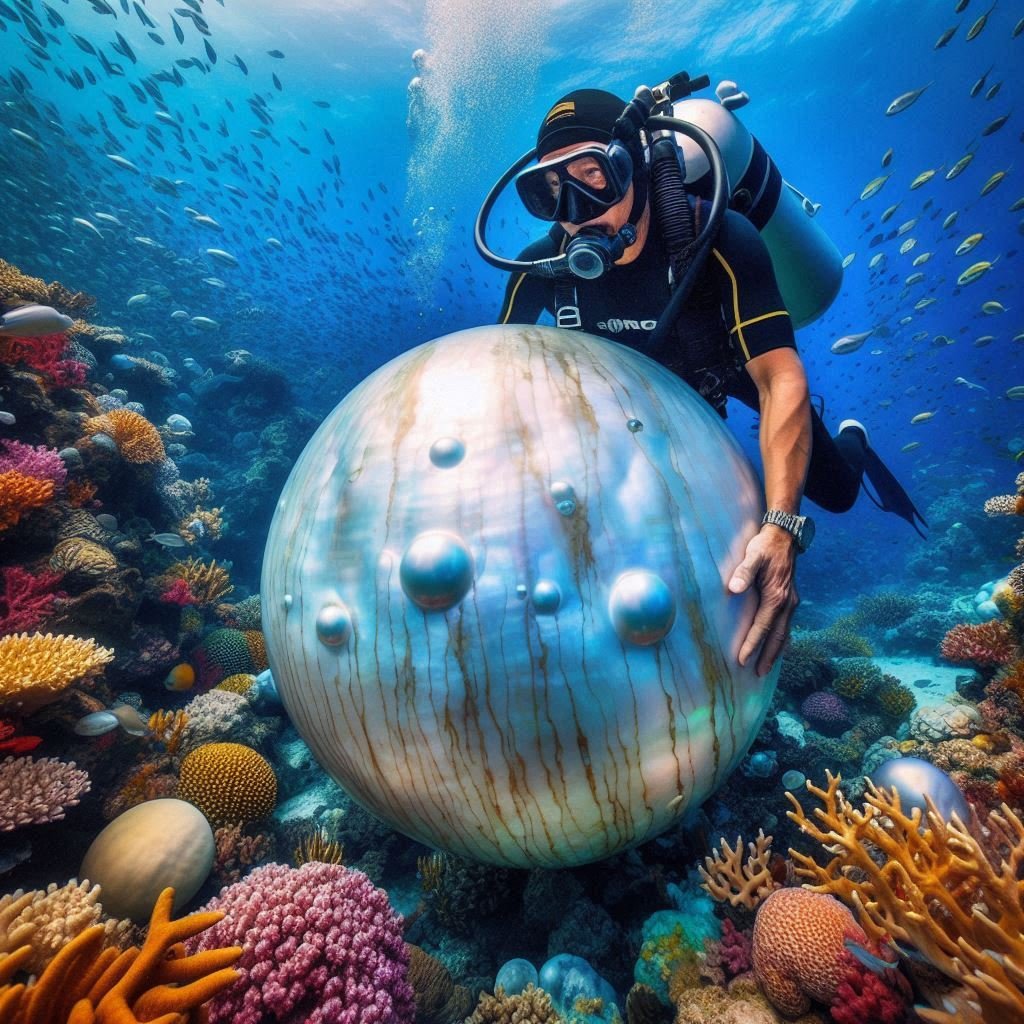The world of gemstones and precious minerals has long captivated human imagination, but few discoveries have sparked as much intrigue and wonder as the Pearl of Allah, also known as the Pearl of Lao Tzu. This extraordinary gem, found in the waters surrounding the Philippine island of Palawan, holds the distinction of being the largest known pearl in the world. Its immense size, unusual shape, and fascinating history have made it a subject of great interest for gemologists, historians, and the general public alike. This blog post delves into the remarkable story of the Pearl of Allah, exploring its discovery, characteristics, historical significance, and the ongoing debates surrounding its provenance and value.
The Discovery of the Pearl of Allah
The Fateful Day in 1934
The story of the Pearl of Allah begins on a seemingly ordinary day in May 1934, off the coast of Palawan, an island province in the Philippines. A local diver named Etem Imam was working in the waters near Brooke’s Point when he made an extraordinary discovery that would soon capture the world’s attention. Imam, diving for the Palawan Pearl Company, encountered a giant clam unlike any he had seen before. Little did he know that within this massive mollusk lay a treasure that would become the stuff of legends.
The Tragic Twist
The discovery of the pearl, however, was marred by tragedy. As Etem Imam attempted to retrieve the enormous clam, he became trapped and drowned. His fellow divers, upon recovering his body, also retrieved the giant clam that had claimed his life. When they opened the clam, they were astounded to find an enormous, unusually shaped pearl inside. The pearl’s discovery was thus tinged with both wonder and sorrow, a bittersweet beginning to its remarkable journey.
Physical Characteristics of the Pearl of Allah
Size and Weight
The Pearl of Allah is renowned for its extraordinary size, which sets it apart from all other known pearls. Here are its key physical attributes:
| Attribute | Measurement |
|---|---|
| Weight | 6.4 kg (14.1 lb) |
| Length | 24 cm (9.45 inches) |
| Width | 14 cm (5.51 inches) |
These dimensions make it significantly larger than any other pearl ever recorded, earning it the title of the world’s largest pearl.
Unique Shape and Appearance
Unlike the spherical shape typically associated with pearls, the Pearl of Allah has a distinct, irregular form often likened to that of a human brain. Its surface is not smooth but rather exhibits a complex pattern of ridges and folds. The pearl’s color is predominantly white with hues of cream and beige, displaying a subtle luster characteristic of natural pearls.
Composition and Formation
The Pearl of Allah is classified as a non-nacreous pearl, meaning it lacks the iridescent quality found in more common pearls. It is composed primarily of calcite, formed within a giant clam (Tridacna gigas) rather than the oysters typically associated with pearl formation. This unique origin contributes to its unusual size and shape.
The Scientific Significance
A Rare Specimen
The Pearl of Allah represents a rare example of pearl formation in giant clams, providing valuable insights into the biological processes of these massive mollusks. Its existence has sparked numerous scientific studies aimed at understanding the conditions that lead to such extraordinary pearl growth.
Implications for Marine Biology
The discovery of this pearl has significant implications for marine biology, particularly in the study of giant clams and their role in reef ecosystems. It highlights the potential for these creatures to produce massive calciferous structures, raising questions about the environmental factors that contribute to such formations.
Historical and Cultural Significance
The Name and Its Origins
The pearl’s name, “Pearl of Allah,” carries cultural and religious significance. According to some accounts, the pearl was named by Wilburn Dowell Cobb, an American who acquired it in 1936. The name is said to reflect the belief that the pearl’s shape resembles a turbaned head, linking it to Islamic imagery.
Legends and Myths
Over the years, numerous legends have emerged surrounding the Pearl of Allah. Some tales suggest that it was revered by ancient Chinese philosophers, while others claim it was once owned by Lao Tzu, the founder of Taoism. These stories, while largely unsubstantiated, have contributed to the pearl’s mystique and cultural allure.
The Journey of the Pearl
Early Ownership and Transfers
After its discovery, the pearl changed hands several times within the Philippines. Its early history is somewhat obscure, but it is known to have been in the possession of various local chieftains before coming to the attention of Wilburn Dowell Cobb.
Wilburn Dowell Cobb’s Acquisition
Cobb, an American botanist and adventurer, learned of the pearl during his travels in the Philippines. In 1936, he managed to acquire it from a local chieftain, reportedly in exchange for medical treatment and a promise of American citizenship. Cobb brought the pearl to the United States, where it began to gain international attention.
Subsequent Ownership and Exhibitions
Following Cobb’s possession, the Pearl of Allah has had several owners and has been displayed in various exhibitions around the world. Its journey has included:
- Display at Ripley’s Believe It or Not!
- Ownership by Peter Hoffman and Victor Barbish
- Legal disputes over ownership and value
- Current status in a private collection
Scientific Analysis and Authentication
Gemological Studies
Over the years, the Pearl of Allah has undergone several scientific examinations to verify its authenticity and understand its composition. Prominent gemological institutions have conducted studies, confirming its status as a genuine, naturally formed pearl.
X-ray and Chemical Analysis
Advanced techniques such as X-ray diffraction and chemical analysis have been employed to study the pearl’s internal structure and composition. These studies have revealed:
- The pearl’s concentric growth pattern
- Its primarily calcite composition
- The absence of any artificial enhancements or treatments
The Pearl’s Value and Economic Impact
Appraisals and Valuations
Determining the value of the Pearl of Allah has been a subject of considerable debate and speculation. Various appraisals have been conducted over the years, with widely differing results. Here’s a summary of some notable valuations:
| Year | Appraiser | Valuation |
|---|---|---|
| 1967 | Lee Sparrow | $3.5 million |
| 1982 | Gemologist Michael Steenrod | $42 million |
| 2007 | Colorado gemologist Jeremy Norris | $93 million |
It’s important to note that these valuations are subjective and influenced by various factors, including market conditions and the unique nature of the pearl.
Economic Implications
The Pearl of Allah’s high valuations have significant economic implications:
- Impact on the rare gem market
- Potential for tourism and exhibition revenue
- Insurance and security considerations
Controversies and Debates
Authenticity Challenges
Despite scientific verification, some skeptics have questioned the pearl’s authenticity. These debates often center around:
- The unusual size and shape of the pearl
- The rarity of pearl formation in giant clams
- The lack of comprehensive historical documentation
Ownership Disputes
The pearl’s high value and cultural significance have led to several legal battles over its ownership. These disputes have involved:
- Claims by descendants of original owners
- Disagreements among recent owners and investors
- International debates over cultural patrimony
The Pearl of Allah in Popular Culture
Media Coverage and Public Interest
The Pearl of Allah has captured public imagination, featuring in numerous media reports, documentaries, and books. Its story has been covered by major news outlets, contributing to its status as a cultural phenomenon.
Influence on Art and Literature
The pearl’s unique story has inspired various artistic and literary works, including:
- Fictional accounts based on its discovery
- Artistic representations in various media
- Inclusion in educational materials about gemology and marine life
Conservation and Environmental Considerations
Habitat Protection
The discovery of the Pearl of Allah has highlighted the importance of preserving the marine ecosystems where giant clams thrive. Conservation efforts in Palawan and similar regions have been influenced by the awareness raised by this remarkable find.
Sustainable Pearl Farming
The pearl’s existence has also sparked interest in sustainable pearl farming practices, particularly those involving giant clams. This has led to:
- Research into environmentally friendly pearl cultivation
- Efforts to protect and propagate giant clam populations
- Increased awareness of the ecological role of mollusks in marine ecosystems
Future Prospects and Ongoing Research
Potential for New Discoveries
The existence of the Pearl of Allah raises the possibility of other extraordinary pearls yet to be discovered. Marine biologists and gemologists continue to explore the potential for similar formations in giant clams and other mollusk species.
Advancements in Pearl Research
Ongoing scientific studies inspired by the Pearl of Allah focus on:
- Understanding the biological processes behind exceptional pearl growth
- Developing new techniques for pearl cultivation and assessment
- Exploring the genetic factors that contribute to unusual pearl formation
Conclusion
The Pearl of Allah stands as a testament to the wonders of the natural world and the enduring human fascination with rare and beautiful objects. Its discovery off the coast of Palawan has not only enriched our understanding of pearl formation and marine biology but has also sparked imagination and debate across cultures and generations. As scientific research continues and new chapters are added to its already colorful history, the Pearl of Allah remains a subject of wonder, study, and admiration. Whether viewed as a natural marvel, a cultural treasure, or a valuable gemstone, it continues to captivate and inspire, reminding us of the extraordinary potential hidden within the depths of our oceans.
Disclaimer: This article is based on available information and research up to the time of writing. While every effort has been made to ensure accuracy, some details may be subject to ongoing debate or new discoveries. Readers are encouraged to consult current scientific literature and authoritative sources for the most up-to-date information. If you notice any inaccuracies, please report them so we can promptly make corrections.



